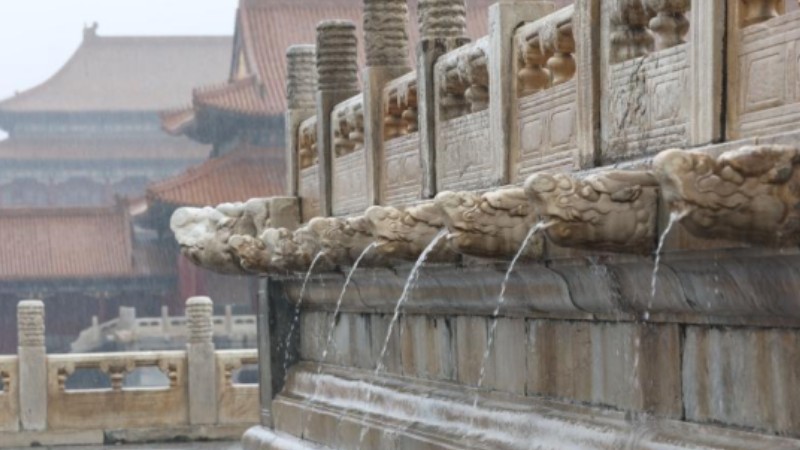Ribbons feature ancient techniques

The medal ribbon for the Chengdu FISU World University Games is masterfully crafted by incorporating millennia-old weaving techniques of Shu brocade. ZHANG WEI/CHINA DAILY
Bands holding medals incorporate Shu brocade weaving from Han Dynasty
At the award ceremony for the rhythmic gymnastics individual all-around event, the smile of gold medalist Fanni Pigniczki from Hungary shined as brightly as the gold medal itself on Sunday night at the Chengdu Sport University Gymnasium.
Equally radiant was the ribbon around her neck.
"The gold medal ribbon is very special, and I really love it," said the 23-year-old Hungarian gymnast.
The medal ribbon for the FISU World University Games, held in Chengdu, Sichuan province, was masterfully crafted by incorporating millennia-old weaving techniques of Shu brocade.
The ribbon features two primary colors, blue on the front and red on the back. It elegantly incorporates elements that reflect Chengdu's historical and cultural significance, such as hibiscus flowers and the sun bird of the Jinsha archaeological site in Chengdu, which create a mesmerizing interplay of colors when reflected under natural light.
The medal ribbon was created by the Chengdu Shu Brocade Research Institute and professor Ma Liwa and her team from Art College of Chinese and ASEAN Arts, part of Chengdu University.
"Crafting such delicate and complex patterns on a ribbon measuring approximately 2.5 centimeters wide and 105 cm long, using the techniques of Shu brocade is truly no small feat," said Hu Guangjun, director of the Chengdu Shu Brocade Research Institute.
Originating during the Han Dynasty (206 BC-AD 220), the Shu brocade weaving skill is one of China's national intangible cultural heritages. It is regarded as one of China's four famous brocades, along with Song brocade from Suzhou in Jiangsu province, Yun brocade from Nanjing in Jiangsu and Zhuang brocade from the Guangxi Zhuang autonomous region.
According to Hu, Shu brocade played a prominent role in trade along the Silk Road, elevating its status as a cultural emblem of Chengdu and a symbol of cultural exchange between East and West.
"The art of weaving Shu brocade stands as a brilliant testament to the ingenuity of our ancient laborers," said Hu, a 74-year-old inheritor of this traditional skill.
He explained that Shu brocade features a variety of structural patterns such as plain, twill, satin and their combinations.
"The surface of the medal ribbon for the games displays a clear and distinct effect, perfectly capturing the aesthetic beauty of Shu embroidery," said Hu, who has been practicing Shu brocade for over five decades. "Despite its apparent irregularities, a gentle touch reveals a smoothness akin to a baby's skin."
The ribbon that connects the athletes to the medals symbolizes Chengdu's gracious hospitality and heartfelt blessings as the host city, he said.
"With every thread, we weave a tapestry of prosperity and beauty, reminiscent of its ancient journey along the Silk Road, fostering a delightful dialogue between Chengdu and the world," he added.
Ma recalled that her team collaborated closely with the Chengdu Shu Brocade Research Institute — extensively gathering information, making numerous revisions and communicating nearly a hundred times. They rejected and restructured the design several times, presenting more than 40 proposals before finalizing it.
"We needed to gain a comprehensive understanding of the intricate weaving techniques and distinct color characteristics of Shu brocade to craft a pattern that perfectly complements its application," she said.
Amidst boundless creativity, the design and production of the ribbon faced several unexpected challenges. For example, achieving symmetrical patterns on both sides of the Shu brocade proved to be difficult. To address this, the design team innovatively created a reverse design with red cloud patterns, seamlessly binding the two sides together.
However, this approach gave rise to new challenges. Due to the double-sided design, the ribbon's thickness increased, making it difficult to smoothly pass through the medal's concealed interface.
"Simply reducing the ribbon's width would cause an imbalance in the proportion between the medal and the ribbon, leading to visual disharmony and other issues," Ma said.
Through continuous material optimization and experimentation, she resolved the problem by reducing the ribbon's thickness and collaborating with the medal designer to widen the medal's interface.
Over the course of five months, from pattern design to machine production, the process unfolded. Utilizing 48 kilograms of mulberry silk and undergoing more than 70 meticulous steps, the silk was transformed into 3,000 ribbons, each radiating a mesmerizing and iridescent glow.
Ma is glad to leverage the games as a platform to showcase the art of Shu brocade weaving to both the nation and the world, with a particular focus on reaching the younger generation.
"The ribbon has encouraged Shu brocade practitioners to innovate its patterns, which holds great significance for the better preservation and continuation of this traditional skill," she explained.
In addition to the medal ribbons, they have also designed and crafted a range of games-related products, including mirror casings made with Shu brocade fabric, as well as incorporating Shu brocade patterns on fishermen's hats and bags.
"The bags are particularly popular among youngsters," Ma added.
Photos
Related Stories
- Chinese heritage attracts Universiade athletes in Chengdu
- Having a ball while finding the winning rhythm
- A golden opportunity to forge friendships
- It's a 'Yes!' as romance wins the day
- The opponent I need to overcome is in the mirror: FISU first gold medalist Cao Maoyuan
- Crowd support cheers athletes in Chengdu
- Universities urged to help students grow
- Explore the Chengdu FISU Games Village with Rongbao
- Athletes visit panda research base
- 'Peppers' relish working in village
Copyright © 2023 People's Daily Online. All Rights Reserved.









